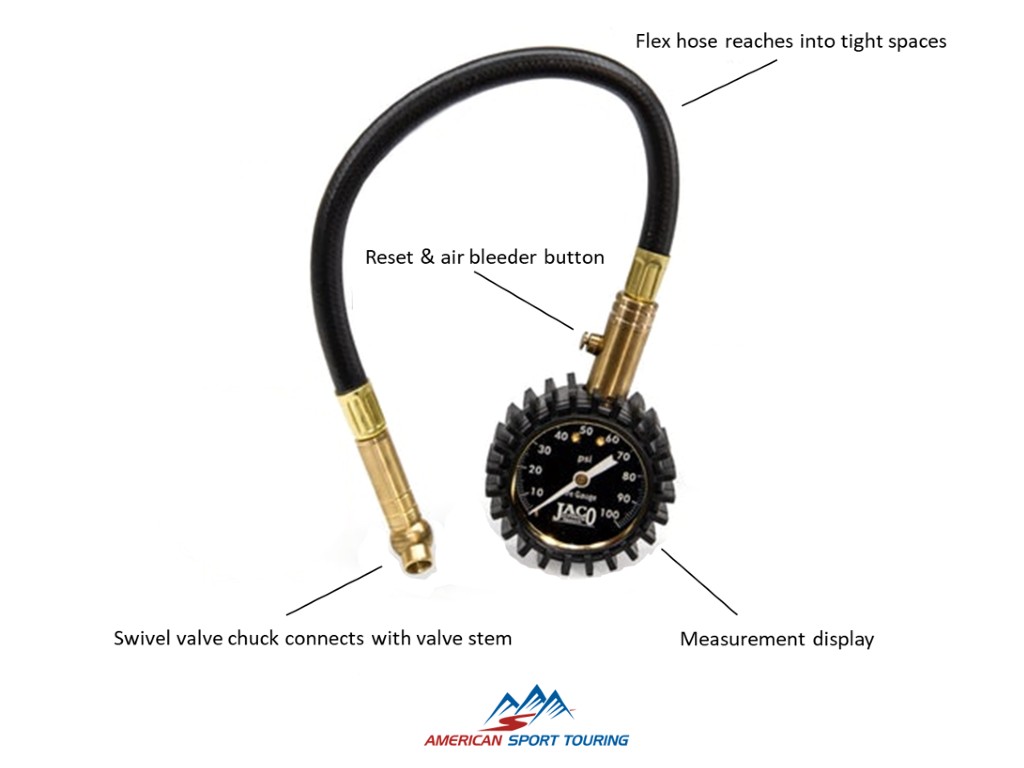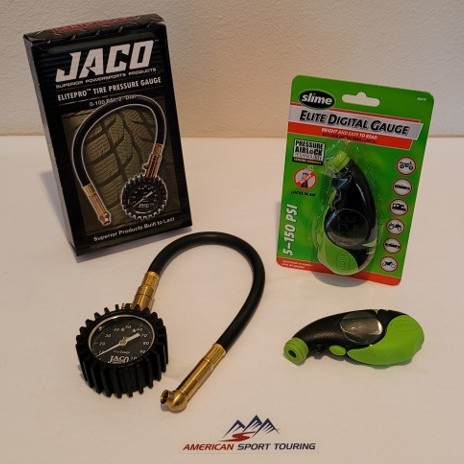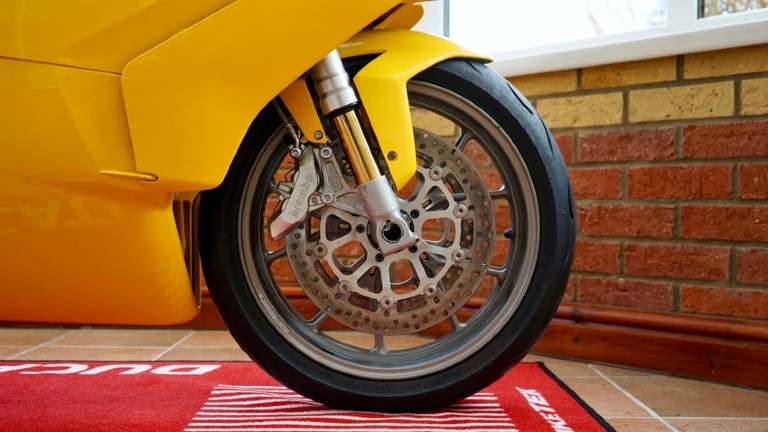
How to Pick the Right Tire Gauge
A tire gauge is a simple tool. And when used regularly, the easiest way to improve rider safety and at the same time motorcycle handling and performance.
Not convinced? According to the National Highway Safety Association, tire failure accounts for about 11,000 vehicle crashes a year, and under-inflated tires are one of the top four contributors. On top of that finding, the NHTSA commissioned a study of motorcycle crashes and again found under-inflated tires were overrepresented in motorcycle crashes.
These, together with better fuel economy and tire wear, are why the most frequently used tool in every motorcyclist’s kit should be a tire gauge. This article shares insights that will help you choose a gauge that’s right for your situation.
Tire Gauge Anatomy
All tire gauges have two features in common: a display that shows air pressure readings, and a chuck that attaches to the tire valve. Many also have a bleeder valve to release excess air pressure. What differentiates one gauge from the next however is the way these common features are implemented in the product.
Displays come in two styles. Digital gauges use sensors and circuits to compute air pressure and display results on an LCD panel. Analog gauges on the other hand use mechanical parts to sense pressure and use a mechanical needle and scale to show results.

Pretty much every tire gauge sold in North America measures in PSI (pounds per square inch). Most digital gauges, and some analog gauges as well, are designed to also display in kPa (kilopascals, commonly used in Europe) and Bar (equal to 100 kilopascals and rarely used to measure tire pressure).
The chuck, that part that connects to the tire valve, may be part of the gauge housing as is the case with the Slime Elite that we tested, or attached by a flexible hose like the Jaco gauge. Typically, the chuck swivels to make connecting to the tire easier while still allowing the user to position the display for easy reading.
Finally, gauges often include a bleeder valve used to easily reduce pressure without having to disconnect from the tire valve between measurements.
A Word About TPMS
For those who have a TPMS (tire pressure monitoring system), remember these systems give an approximate (and not necessarily accurate) measurement but most importantly alert a rider when a tire is under-inflated. The TPMS should not be used to inflate tires to their recommended level.
Digital or Analog – Pros and Cons
Although a seemingly straightforward decision, there are some important considerations to keep in mind when picking a tire gauge. As a guide, we compared key features of a Jaco ElitePro 0-100 PSI, 2 inch analog gauge with those of an Elite Digital 5-150 PSI gauge from Slime. Both are well reviewed and recognized best-in-class products.

The criteria that follow will help you evaluate features and choose between an analog and digital model that best meets your needs.
Price – No advantage; not a significant consideration when selecting a good quality product
Good quality tire gauges, digital and analog, are available from a wide assortment of manufacturers each combining features in unique ways and selling at prices ranging from around $15 to more than $100. Professional gauges, the ones MotoGP race teams use, can run several hundred dollars. The typical consumer-grade product costing less than $30 works well for just about everyone else.
Measuring Units – Advantage digital; accurately shows measurements in multiple scale units
Motorcyclists wanting to measure pressure in something other than PSI should consider a digital gauge. Digital gauges easily switch between PSI, kPa, and Bar and can even convert a reading between scales. Analog gauges sometimes have a second scale on the dial.
Accuracy – Advantage digital; accuracy is superior across the full range of measurement
Analog tire gauges are designed to give the most accurate reading in the middle of their measurement range. For example, an analog gauge that measures from 0 to 100 PSI will give the most accurate readings between 25 and 75 PSI. Readings above and below those thresholds are less accurate. Knowing this, purchase a gauge with a middle range that covers the recommended tire pressure for your motorcycle.
By contrast, digital gauges are equally accurate across their entire measurement range.
The actual accuracy of an analog gauge is usually +/- 1% or2% in the middle of the scale, while digital gauges are accurate between +/- 0.5% and 1% across their entire range.
Precision – Advantage digital; more precise and easier to read measurements
Readings on an analog gauge use a needle and scale typically marked in whole PSI increments from 0 to whatever maximum the gauge is designed to handle. Getting a precise reading can be difficult particularly when the needle lands somewhere between units. Consequently, it’s best to think of analog gauges as precise to the nearest whole unit measure.
Digital gauges take the guesswork out of reading results. The display clearly shows a precise reading typically to the nearest 10th of a PSI or 100th of a Bar.
Certification Standards – Advantage analog; only analog gauges have an accuracy standard for benchmarking
Analog gauge accuracy may be certified against ANSI Standard B40.1; however, no such standard exists at this time for digital gauges. Better analog gauges are manufactured and calibrated to meet the ANSI standard.
Usability – No advantage; both offer multiple models which work well depending on the situation
We looked at useability in several ways starting with how easily the gauge connects to the valve stem. The distinction here is based on ergonomics rather than technology. Gauges with flexible hoses are easier to fit into tight spaces, like between large rotors on sport bikes. Lacking a hose, one has to fit the entire gauge between wheel spokes.
Secondly, consider the quality of the chuck. Most gauges, digital or analog, use a brass chuck that presses over the valve stem. Inevitably, some air hisses out in the process. Slime introduced a patented “no hiss” chuck design that is surprisingly effective. The Slime Elite gauge we tested worked so well we actually wondered if it had seated at all.
Also look for a gauge that holds readings after being removed from the tire valve. This feature is helpful when the position of the valve stem makes seeing the display difficult or when working in low light. The reset/bleeder button resets the gauge back to zero.
When a tire is over-inflated, a built-in air bleeder makes adjustments quick and easy without removing the gauge from the valve.
And finally, check the readability of the gauge itself. For analog gauges, consider if the dial is large enough to easily read. Is it illuminated in some way for low-light situations? Digital gauges are highly readable. Taking readability a step further, the Slime Elite Digital gauge comes with a built-in LED for night use.
Durability – No advantage; both hold up well under everyday use
Some tire gauges are designed to carrying along on a ride, while others are tough enough to toss in a toolbox. Less expensive gauges are not necessarily less durable. In fact, the two models we tested withstood considerable abuse from being dropped to bouncing around in a toolbox. They were scuffed up and suffered a scratched (not cracked) dial and LCD, but appearances aside both continued to work flawlessly.
Reliability & Warranty – Advantage analog; no batteries required
Analog gauges over time become less accurate as the mechanical parts wear. Digital gauges on the other hand require new batteries periodically depending on usage. That said, both designs will last for years. Products from Jaco come with a lifetime warranty while Slime products carry a 1-year warranty.
Summing it Up
Choosing a gauge comes down to selecting one that can reach between the wheel to the valve stem with the least amount of effort while giving an accurate and easy to read measurement. Gauges with extension hoses work well when valve stems are hard to reach while digital gauges give the most accurate measurement.

With so many affordable choices, every toolkit should include a tire gauge, and every rider should use it often to maximize both safety and ride performance. That includes riders on motorcycles equipped with a TPMS system.
To learn more about setting tire pressures read Find the Best Tire Pressure For Your Motorcycle and for more on repairing a flat tire read How to Repair a Motorcycle Flat Tire.
[placeholder text]
Your response is used by American Sport Touring only, we do not store or sell your information.
Please read our Privacy Policy.

by John DeVitis, Editor and Publisher
John DeVitis, Editor & Publisher of American Sport Touring, has spent years riding and writing with a focus on long-distance, performance-oriented motorcycling. His time on the road has revealed little-known routes across the United States and Canada, along with practical insights into the bikes, gear, and techniques that matter to sport touring riders. He draws on this experience, together with a background in digital publishing, to guide the editorial principles and clear vision behind American Sport Touring, delivering content riders can trust.




